Mitch Pinney
Shortcuts
06/12/2024—31/01/2025
Opening reception: Friday 6th December, 2024
Exhibition Catalogue
In 2020 my days fell into a rhythmic routine where I would wander with my camera behind the Coburg drive-in cinema and along the serpentine banks of the Merri Creek. Each evening, I returned home to develop my film, repeating the journey the following day. It was during these excursions that I found a treehouse cradled by the banks. The treehouse could be reached only by foot over stepping stones strewn across the creek bed. It felt like a special location, detached from the tumult and turmoil of the world beyond.
In the years since the lockdowns lifted, I have returned regularly to the treehouse, witnessing its transformations with the seasons. Crude messages and confessions have been scrawled across its plywood walls overgrown blackberry bushes creep ever closer. Under its shelter, a man, recently rendered homeless by the housing crisis, has carved out a sanctuary for himself and his two dogs.
Shortcuts unfolds as an ambling exploration of the treehouse and the wilderness that contains it. Echoing the path of its creation, it travels an undefined trajectory, following flowered sidepaths and leaf-strewn switchbacks, detecting fleeting moments and glimpses of light, circling back upon and intersecting itself. The contours of this exploration reflect the internal musings during its making, and, subtly - similar to the manner in which a sculptural form has its obverse in the mold from which it emerged - gestures toward the broader social and economic environment which has given rise to this space-as-sanctuary.
Mitch Pinney
Mitch Pinney is a photographer based in Naarm (Melbourne) who draws from his roots in the Northern Rivers of New South Wales.
His photography employs a black and white snapshot style, exploring the connections between synchronicity, chance encounters, and inner and outer experiences.
Working within the confines of black and white photography, Pinney makes connections between images that might otherwise remain disjointed. This reduced palette allows him to focus his work, balancing documentation and fantasy.
Instagram - @mitchpinney
Website - mitchpinney.net

Adrian Jing Song,
Lê Nguyên Phương,
Laura Chen
Family Album:
Re-Imagining Memory
08.11.2024 - 01.12.2024
Exhibition opening: Friday 8th November, 6-8pm
Curated by Yuzhen Cheng
What is family? In what ways can we remember and understand it? What of family is preserved over time amidst the blurred apparitions of our memories? How do family images shape both personal and collective memory, and how do they construct a sense of identity?
Drawing on senses of authenticity, on everyday life, and our relationship with the past, the "family album" provides a sense of personal identity and a connection to one's own history. This exhibition combines unique works by three contemporary artists of Southeast and East Asian backgrounds and invites reflection on the family album as a repository of memories that allow individuals to construct narratives about their past, familial relationships and their position within a broader historical and cultural context. Through artistic techniques such as cutting, folding, collage, and juxtaposition, and through the media of photos, video, and installation, family albums are represented as "Les Lieux de Mémoire" (sites of memory) — spaces where narratives and memories are constructed and reconstructed. At the same time, these albums become a field where past stories are re-imagined.
Technically, this exhibition aims to transcend the boundaries of pure image interpretation within the realm of contemporary artistic photography. Methodologically, it explores the powerful role and impact of photography within historical and anthropological narratives.
@phuong.io @adrianjsong @lauramchen @pallaksch.pallaksch
Drawing on senses of authenticity, on everyday life, and our relationship with the past, the "family album" provides a sense of personal identity and a connection to one's own history. This exhibition combines unique works by three contemporary artists of Southeast and East Asian backgrounds and invites reflection on the family album as a repository of memories that allow individuals to construct narratives about their past, familial relationships and their position within a broader historical and cultural context. Through artistic techniques such as cutting, folding, collage, and juxtaposition, and through the media of photos, video, and installation, family albums are represented as "Les Lieux de Mémoire" (sites of memory) — spaces where narratives and memories are constructed and reconstructed. At the same time, these albums become a field where past stories are re-imagined.
Technically, this exhibition aims to transcend the boundaries of pure image interpretation within the realm of contemporary artistic photography. Methodologically, it explores the powerful role and impact of photography within historical and anthropological narratives.
@phuong.io @adrianjsong @lauramchen @pallaksch.pallaksch

Starry Kong
Nothing Gold Can Stay.
Nothing Dark Will Last.
11.10.2024 - 03.11.2024
Exhibition opening: Friday 11th October, 6-8pm
Exhibition runs Friday 11 October — Sunday 3 November.
Two bodies of work by Kong presented side by side
“It’s still Dark, but sometimes I see the Stars”
For the past 10 years, I’ve asked myself, what is the point for being alive if I cannot feel the joy — if I don’t even want to exist?
“Living with depression” — it’s like there is a tall, thick wall built in front of my heart, and nothing can pass through. Sunlight, happiness, and hopes are blocked out. Darkness, dread, and desperation are locked in. It’s like living in a Black Hole, and I don’t know how long I still need to stay.
At times, I begin to see the stars. Even though there are not many, and they are so tiny, they are bright and stunning, right there, shining on me. You, each one of you, are the stars in my firmament, are the stars that keep me alive.
“You can’t walk this earth forever. Someday you will have to fly”
For more than 10 years, I have been suffering from depression. It has caused me to think about life’s meaning. My feelings about death are paradoxical — I dread to think about the demise of people I love, but I feel indifferent and apathetic about my own.
In 2018, my Australian mother, for whom I felt a deep affection, passed away due to brain cancer. This was the first time I witnessed the death of someone I knew, and I experienced a profound depth of grief. I encountered uncertainty about my significance in the larger scheme of the universe. My understanding of such concepts and beliefs about my meaning in life were challenged.
I encountered a sentiment a few days after she passed away — ’You can’t walk this earth forever; someday you will have to fly’. This is what she used to tell her sons when they were kids. Somehow these words consoled me, and have accompanied me since. Her words inspire me not to be obsessed with the state of living and to accept the mortality as part of life.
@starrykong
https://www.starrykong.com

Hillvale Presents:
Ben Hattingh
Clem McNabb
EJ Hassan & Kaede James Takamoto
Ed Gorwell
Gabrielle Hall-Lomax
Harley & Handen
Lina Zackariya
Mert Berdilek
Sarah Cutbush
Sophie Smith
Wilhelm Philipp
13.09.2024 - 06.10.2024
Exhibition opening: Friday 13th September
Exhibition runs Friday 13 September — Sunday 6 October
Curated by Hillvale Gallery
Hillvale Presents our major group exhibition for 2024. Ben Hattingh’s work taps into this undercurrent of disillusionment. His stark, unpeopled landscapes reflect the eerie calm of a society where familiar structures no longer function as they once did, leaving behind an unsettling void. Clem McNabb’s artful and intimate eye depicts a community of trans people they met just after turning 21. Ed Gorwell’s selection of everyday moments mainly focuses on unplanned still life arrangements allowing the viewer to reconsider the relationships that exist between the spaces, objects and people. Kaede James Takamoto and EJ Hassan present their collaborative project ‘Palaver’ is an on-going visual dialogue centered around female identity and their response to feeling seen. Gabrielle Hall-Lomax’s collection of images are from an ongoing project exploring identity, memory, and intergenerational connections among women, with a focus on matrilineal heritage. Harley & Händen’s practice showcases the life of sex workers through playful film photography. Lina Zackariya maintains a deep connection to her Islamic faith and South-Asian culture, through a focus on the resilience and beauty in maintaining tradition while navigating and integrating a different cultural landscape. Mert Berdilek, an Australian-Turkish filmmaker and photographer traversed 8000km+ on road across Türkiye, to explore how the country has changed, or hasn't since its formation 100 years ago. Sarah Cutbush’s project Hidden Valley encapsulates her interest in speculative documentary photography, exploring how this way of working can be used to address silences within the community archive. Sophie Smith is interested in the representation of feminine-presenting people in fashion and how this influences individual constructions of femininity. Wilhelm Philipp’s delves into Australia’s thriving paleontology scene in ‘Dinosaur Dreaming’, through documenting four digs spanning from 2019-2023.

Jake Nemirovsky
Big Bug
27.07.2024 - 18.08.2024
Exhibition opening: Saturday 27 July, 2024, 3-5pm
Jake Nemirovsky’s solo exhibition debut Big Bug opens at Hillvale Gallery on Saturday 27 July. To coincide with the opening, Jake’s first solo publication of the same title, published by Tall Poppy Press, will be launched.
Try to remember a moment from when you were young. What did it feel like then? How does it feel now? Can you describe it?
Can you pinpoint a place or are we back where we started?
The echoes of my memory fade and swell over time; they tell a story that I want to recall. I can remember the taste, but I can’t quite taste it.
These are closer to memories of a memory,
like the pages of so many photo albums that were never made. Like the reflections of a world that I thought were real. I can remember the sound, but I can’t quite hear it.
The camera pricks the surface of the visual world to stir all that is dormant within us.
I'm interested in how a photograph affects the viewer by evoking familiarity, even if what they see isn’t a person, place or time they have known. When living memory fails, we reach for photographs to remind us. They satisfy our yearnings to return to the moments sweetened by passing time.
It has no theme or arc, but I hope the work can be likened to something we all share. It’s my version of the after-dinner ritual of thumbing through boxes of soft-cornered photos, attempting to surface the infinite stories we have stowed away.
Jake Nemirovsky (b. 1994, Melbourne, Australia) is an Australian photographer whose work sits at an intersection between documentary and personal narrative. He focuses on using people, place, objects and landscape to interact with the viewer, forging collaborative perspectives on the lived experience.
Jake’s photographic practice blurs the distinction between what’s real and fictional, reassessing documentary image making conventions in light of an unfolding, post-truth world. He's interested in pairing images to form visual cues in incidental moments of the everyday to connote feelings of familiarity. Jake received a BA Photography (Honours) from RMIT, Melbourne, Australia (2020).

Jake Nemirovsky
in conversation with
Morganna Magee
03.08.2024
Following on from the exhibition launch, we will be hosting an artist talk with Jake and fellow artist Morganna Magee of Tall Poppy Press on Saturday 3 August.

Cecilia Tizard,
Elena Misso,
Isabella Capezio,
Renato Colangelo,
Material Thinking
28.06.2024 - 21.07.2024
Exhibition opening: Friday 28 June, 2024, 6pm
Material Thinking is Process: a series of actions performed by the body in space in relation to other objects.
The darkroom is a site where the body is invited to collaborate with chemicals, metals, light, and time. Physical interventions in the darkroom become repeated gestures: rocking trays, dripping chemistry off corners, counting seconds, coating, layering, and exposing paper to light, water, and chemistry.
Material Thinking is Practice: the application of an idea or method, repeated and performed.
The darkroom is a site where ideas materialise, experimentation and tangential play make space for new applications of the old. Elemental combinations interact and react to the enlarger. Work is constructed, ideas turn over, and turn corners. Darkroom rituals turn into sculptural works as processes intertwine with the body to become practice. Black and white darkroom printing, colour c-type printing, lumen printing, assemblages, and installation define the artist’s practice.
Material Thinking is Agency: a thing or person that acts to produce a particular result.
The darkroom is a site of focus and attention, where the body is in direct contact with the thing it creates. Vague goals and flickering ideas hinge on forces in and out of control.
Material Thinking is Matter: physical substances, a subject or situation.
The darkroom is a site where matter informs the process and creation of the work. Materials are sensitive and responsive; they require care and handling. Touch and sound magnify in the absence of light. Play and precision interact alongside a fan’s rattle, the dryer’s hum, and the swish of water.
Guest-curated by photographer, artist, PhD Candidate and friend of Hillvale, Isabella Capezio.
Elena Misso is an emerging artist currently working primarily with darkroom processes and analogue photography. She completed a Bachelor of Fine Art (Honours) at VCA in 2022, and over the past year have exhibited at TCB, Blindside, Bus Projects, CASPA, and Rising Festival. Recent works have been reproduced as projections for live music, and large-scale transparencies for public display.
Renato Colangelo is visual artist whose practice is focused on and concerned with cultural identity, social awareness and experimentation. Renato predominantly works photography, video and large-scale installations including room size camera obscuras (Standpoint, 2007, Eyes Lies & Illusions, ACMI; Locked Treasure Room, 2011, Centennial Gardens, Sydney; Dark Chamber, 2023, Centre for Contemporary Photography). He’s been exhibiting since 1997 with solo and group exhibitions including residencies in Italy and Australia along with being the recipient of various awards including the prestigious Samstag International Visual Arts Scholarship in 2002. Renato employs analogue techniques in the production of his artwork and runs Nero Darkroom in Melbourne. Renato is also an arts worker, facilitating workshops and working with contemporary artists in printing, fabrication, production and installation.
Isabella Capezio is a photographer and artist living and working on stolen Wurundjeri Country. Isabella’s artwork and research connect themes of failure, power and queerness with landscape. Isabella has organised and facilitated various workshops at home and in the Asia Pacific. They are a PhD candidate experimenting with alternative ways to reflect on place, vision, nature and colonial frameworks of power.
Cecilia Tizard is an emerging artist living and working on Kaurna Land/Adelaide. Graduating from Flinders University with a Bachelor of Creative Arts (Visual Art), Cecilia’s practice primarily engages photography, exploring the intersection between traditional photography and abstract sculpture and installation. Cecilia’s recent work aims to uncover the physicalities of manual photographic practices, drawing parallels between photographic processes and domesticity. In 2022 Cecilia received the Commonwealth Private Undergraduate Award as an outcome to her graduate work in the Helpmann Academy Graduate Exhibition. In 2022, Cecilia exhibited work at ACE and FELTspace, her most recent major body of work was included in Studios:2022 at Adelaide Contemporary Experimental. Cecilia’s work was featured in the Supermarket Stockholm Art Fair in 2023, represented by FELTspace.



Pentax 17 Official Australian Camera Launch
21.06.2024
We’re presenting an exhibition of work by the friendly faces in our lab, shot entirely on the brand new Pentax 17. Printed by the one and only Thirds Fine Art Printing on Ilford paper.
Featuring images by James Bugg, Anne Moffat, Michael Thomas, Andy Johnson, Madeline Bishop, Lekhena Porter, Hannah Nikkelson and Jason Hamilton.
The exhibition of these photos is one night only. Come celebrate the launch with us and experience the camera for yourself.

Marlo W
Foreground:
Portraits of Older Transgender and Gender Diverse People
17.05.2024 - 09.06.2024
Exhibition opening: Friday 17th May, 2024, 6pm
Hillvale Gallery is humbled to present the work of Naarm based photographer and artist Marlo W which will coincide with the launch of their solo publication of the same title.
Buy Foreground online or instore at Hillvale.
Foreground is a celebration of a group of people who are often overlooked. Sharing the stories of older transgender and gender diverse (TGD) people is integral to demythologising transgender people to the broader community.
“I often think about my older self. Who will be with me when I am older? Will I be living in an aged care home? Will I be living with a lover as we take care of each other? Will I be living with friends? Wherever I end up, I want to be safe and know that the people around me are empathetic and understanding of me as a person, and of my transness.
“There is a severe lack of representation of older transgender and gender diverse (TGD) individuals in the media. As a result, their intimate lives — their thoughts, passions, interests, hopes, struggles, regrets — become something of a mystery. It is important for people to see themselves reflected in society. It is how we experience belonging. As a young transgender person, where will I belong if I do not see mysel reflected in my elders?
“These thoughts led me to search for older TGD people in Naarm. It was a lengthy process finding older TGD people to photograph and interview. I relied on community centres, online networks and organisations such as Switchboard Victoria, to connect me with people. I am so grateful to have met the people involved in this series. Their life stories and insights about the world deserve to be heard, seen and validated. I acknowledge this series represents only a small portion of the many TGD people living and gone, and is by no means a direct portrayal of the myriad ways older TGD people live.
“There is a need to platform the voices of older TGD people who have long been marginalised and portrayed negatively by society and in mainstream media. It has been a pleasure taking these portraits and getting to know the older TGD people included in this series. Through this project I wish to bridge generations through mutual understanding, guidance and respect.” — Marlo W
Marlo W is a photographer based in Naarm/Melbourne. Their work engages with queering ideas surrounding embodiment, gender and identity. Through in-camera editing methods, such as distortion and blur, the artist plays with the tropes of photography to re-shape and challenge the nature of perception. By reimagining the body through photography, Marlo navigates their own transness and embodiment. An integral part of their photography is connecting with other queer, transgender and gender diverse people as a means to continually challenge transphobia and gender norms.

Hillvale Photo Trophy
05.04.2024 - 12.05.2024
Thanks to all who participated in our second annual fundraiser.
First prize and recipient of the 2024 Hillvale Photo Trophy
234 – Oli Sansom
Sponsor prizes:
431 – Bartholomew Freebairn
236 – Jess Brohier
389 – Rachelle Amoah
104 – Felix Oliver
691 – Benjamin Brown
We exhibited 970 works that were all available for purchase via QR code and our dedicated Photo Trophy website.

Jahkarli Felicitas Romanis
(Dis)connected to Country
01.03.2024 — 24.03.2024
as part of PHOTO 2024
Mapping the intertwined natures of self and Country.
Australia has a complex history tainted with colonialism, the mass genocide of Aboriginal and Torres Strait Islander peoples, and forced assimilation into the settler colony. The many products of colonialism are still prevalent and thriving today.
(Dis)connected to Country maps the intersections of place, identity, and family, and the way that Aboriginal and Torres Strait Islander people have inextricable connection to the land, as Country and self are intertwined and inseparable. Working with oral histories, the project reflects on the traumatic history of Australia with specific focus on Pitta Pitta Country and the removal of Romanis’ great-grandmother in the early 1900s during the Stolen Generations.
This show aims to disrupt and subvert colonial approaches to image-making and mapping systems, highlighting the omission of significant Indigenous Knowledges. The work critically analyses archive, representation, and new technology, and grapples with the idea that photographs have their own agency. (Dis)connected to Country is a project of revival, healing and mapping back to Pitta Pitta Country.
Jahkarli Felicitas Romanis (born Geelong, 1998, lives and works Naarm/Melbourne) is a proud Pitta Pitta woman, emerging artist, researcher and curator based on Kulin Land. After completing an Honours in Photography degree at RMIT in 2020, she commenced a PhD at Monash in 2021 through the Wominjeka Djeembana Research Lab. Her work is inextricably intertwined with her identity as a Pitta Pitta woman and explores the complexities of her lived experience and the continuing negative impacts of colonisation in what is now known as Australia.
Image: Jahkarli Felicitas Romanis install, 2024. Hannah Nikkelson for Hillvale Gallery.
Talk: Jahkarli Felicitas Romanis and Dr Peta Clancy
02.03.2024
as part of PHOTO 2024
Artist talk Saturday 2 March, 2024, 1-2pm
In-conversation with artist Jahkarli Romanis facilitated by Dr Peta Clancy.
Pitta Pitta woman Jahkarli Romanis discusses her approach to the photographic medium through her project (Dis)connected to Country which is a revival, healing and mapping back to Pitta Pitta Country.
Jahkarli Felicitas Romanis (born Geelong, 1998, lives and works Naarm/Melbourne) is a proud Pitta Pitta woman, emerging artist, researcher and curator based on Kulin Land. After completing an Honours in Photography degree at RMIT in 2020, she commenced a PhD at Monash in 2021 through the Wominjeka Djeembana Research Lab. Her work is inextricably intertwined with her identity as a Pitta Pitta woman and explores the complexities of her lived experience and the continuing negative impacts of colonisation in what is now known as Australia.
Peta Clancy (born Bangerang, 1970, lives and works Naarm/Melbourne) works collaboratively and performatively with and on Country. She creates manually manipulated photographs that layer time, past and present, to re-construct and bring to light hidden histories of Country in a contemporary setting. Australian historical photographs of landscape/place/Country tend to frame Country as an object to capture or obtain. Clancy explores other ways of knowing Country through photography. In 2023 she was awarded a Fellowship from the Australia Council for the Arts. She is a Senior Lecturer and researcher in the Wominijeka Djeembana Indigenous research lab at MADA, Monash University and is represented by Dominik Mersch Gallery.
Image: Jahkarli Felicitas Romanis, Unknown Coordinates III 2022. Courtesy the Artist.

Luke Le
Remember?
01.12.2023 — 31.01.2024
Exhibition opening: Friday 1st December, 6-9pm
Continues until Wednesday 31st January, 2024
Hillvale Gallery is proud to announce the final exhibition of 2023 by long-time friend of Hillvale; Luke Le, as he explores the life of an image in his latest body of work titled Remember?
Le interrogates how time and context add layers of complexity and distortion from the moment an image is generated in the mind's eye, right through until it’s decay.
Remember? features 10+ years of images from the first moments Le began photographing until the present day. The works are heavily processed by hand creating unique objects and prints. He has created a closed loop whereby the only new materials used in production are the inks and frames.
Luke Le (formerly Luke Van Aurich) is an artist and designer based in Sydney/on Gadigal Land working with no formal training. Born in Perth/Boorloo, his career has spanned photography, publishing, furniture design and product design. He has exhibited his photography in various contexts in Australia and internationally.
Le uses photography to comprehend our shared human experience and as a tool to communicate, free from the limitations of language. Aiming to ask many questions and answer very few. He does not seek a resolved project but rather an ongoing, open-ended body of work that allows you to create your own conclusion.
In 2021, Le released his first major artist book What are you looking for? published Perimeter Editions; rerouting notions of diarism and the impromptu to broach new aesthetic and philosophical terrains. As a kind of open letter to a former life in Melbourne, the book forms both an intensely personal gesture and a wider provocation toward the subjectivities and assumptions that underpin photography itself.

Bella Dower,
In Skin and Matter
Dave Carswell,
Grant me the serenity
03.11.2023 — 26.11.2023
Opening reception Friday 3 November, 6-8pm.
View In Skin and Matter catalogue
A harrowing experience of a shed fire on Dower’s parent’s property in Southern Tasmania (2018) is the substrate of her practice. Over forty years of objects, photographs and machinery were rendered unrecognisable: their priceless function as stimuli intensifying the intangible quality of memory. Returning to the debris in an iterative attempt to reconcile the loss of familial material history, In Skin and Matter explores themes of permanence and temporality. Alongside the layered requiem of materials, Dower documents her skin as a vessel of grief embodied.
Bella Dower is a Swedish-born Australian artist whose emerging multidisciplinary practice considers themes of memory and materiality. Growing up in the Czech Republic, Dower moved to Hobart (TAS) before recently relocating to Melbourne (VIC). Dower’s practice moves between the photographic image and sculpture while harnessing silversmithing techniques. Her interest in how the present is perceived and the assumption of ‘flawed’ recollection is a core concern.
View Grant me the serenity catalogue
Grant me the serenity is a character study set in the remote mountains of western lutruwita/Tasmania documenting Peter, an enigmatic and creative individual who migrated to the area six years ago. Peter lives on the cusp of change both in his personal life and amongst the social and environmental developments that play out within the landscape that he inhabits. The work draws together the juxtapositions of intimacy and expanse with humour whilst examining themes of isolation, relational tension, mortality and escapism.
Dave Carswell is a photographer currently based in lutruwita/Tasmania. His photographic practice is rooted in documentary image making with his interests motivated by the intersection between nature, humanity and the built environment. Carswell’s work is concerned with the manner of anthropological intervention on the built landscape with a recent focus towards public space and the way economic, social and ecological influences shape contested spaces.

James Bugg,
Be Angry At The Sun
06.10.2023 — 29.10.2023
View catalogue here
Opening reception Friday 6 October, 6-8pm.
Be Angry at The Sun investigates the concept of slow violence in Australia’s river landscape. The project traces Australia’s Murray Darling Basin, a landscape charged with a dark, violent history of colonisation, the implementation of water politics and the ongoing influence of industry. It examines the degradation of the river landscape as a trace of what it once was—under layers of historical intervention, water management and climate change.
This project began in 2019 after a mass fish kill event saw millions of dead fish float to the surface of the Darling River. I spent the following years tracing the river, speaking to people with extensive knowledge of the landscape in an effort to learn about the river and ecology it sustains. In March 2023, and once again millions of dead fish floated to the surface of the Darling River. Ultimately Be Angry At The Sun is the narrative of a river in crisis.
This project has traversed country cared for by traditional custodians for thousands of generations. The Murray Darling Basin is made up of over 40 Indigenous nations, from the Ngarrindjeri people of the Coorong, where the river meets the sea, to the Barkindji people of the Barka Darling River. The artist would like to acknowledge the Traditional Owners of the country on which this work has taken place. The artist respects the elders and ancestors past, present and emerging and recognises their continued connection to the land and waters and acknowledges that they never ceded sovereignty.
James Bugg (b. 1996) is a documentary photographer based in Naarm/Melbourne, Australia. He received his MA from Photography Studies College in 2022. Bugg is interested in narratives exploring the relationships between people, place and circumstance. He was the recipient of the 2018 Moran Contemporary Photographic Prize and was recently selected as one of the British Journal of Photography’s ‘Ones to Watch’ in 2022. His work has been shown in the National Photographic Portrait Prize, the Moran Photographic Prize and has been exhibited as a part of PHOTO 2022 International Festival of Photography and Ballarat International Foto Biennale.
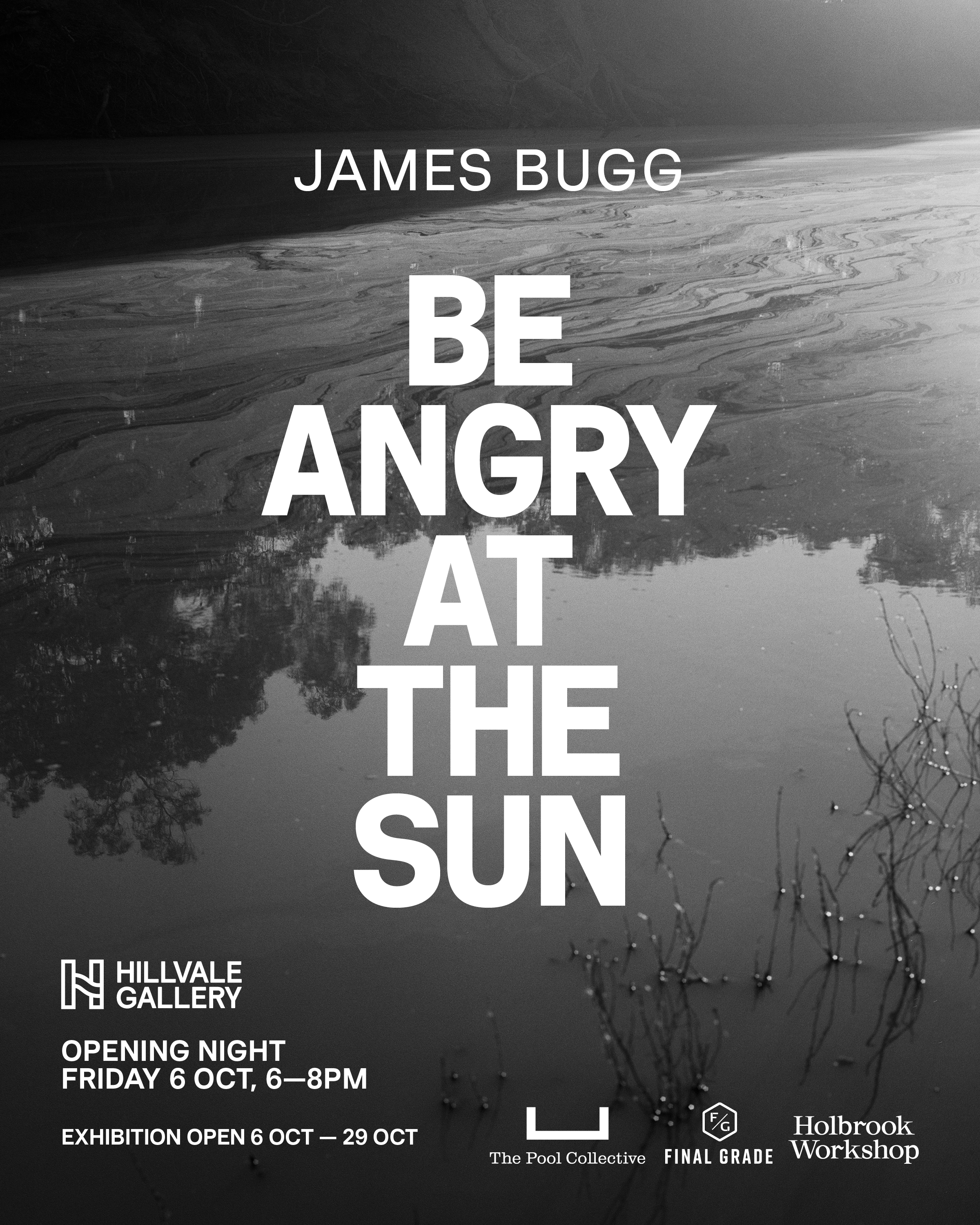
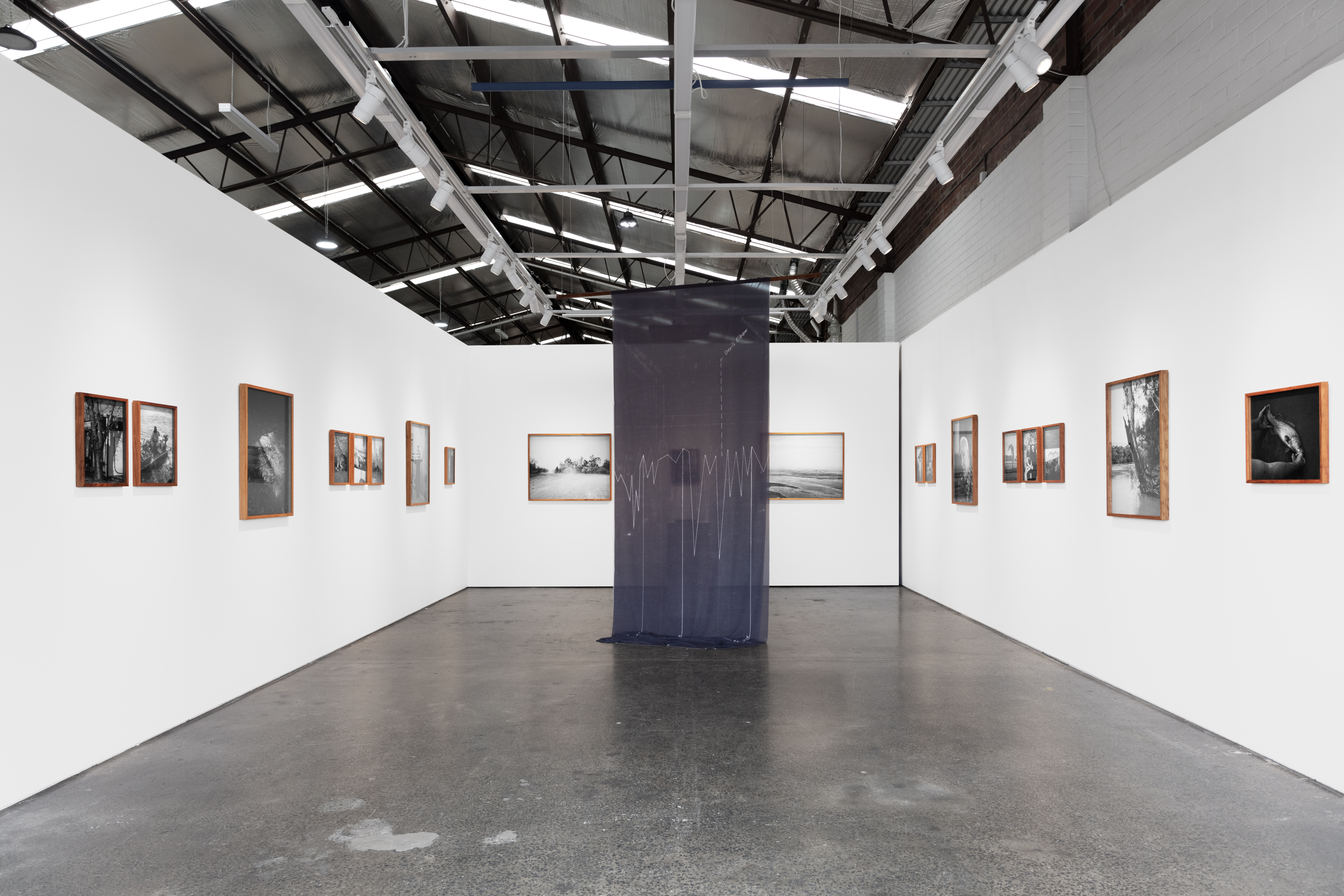



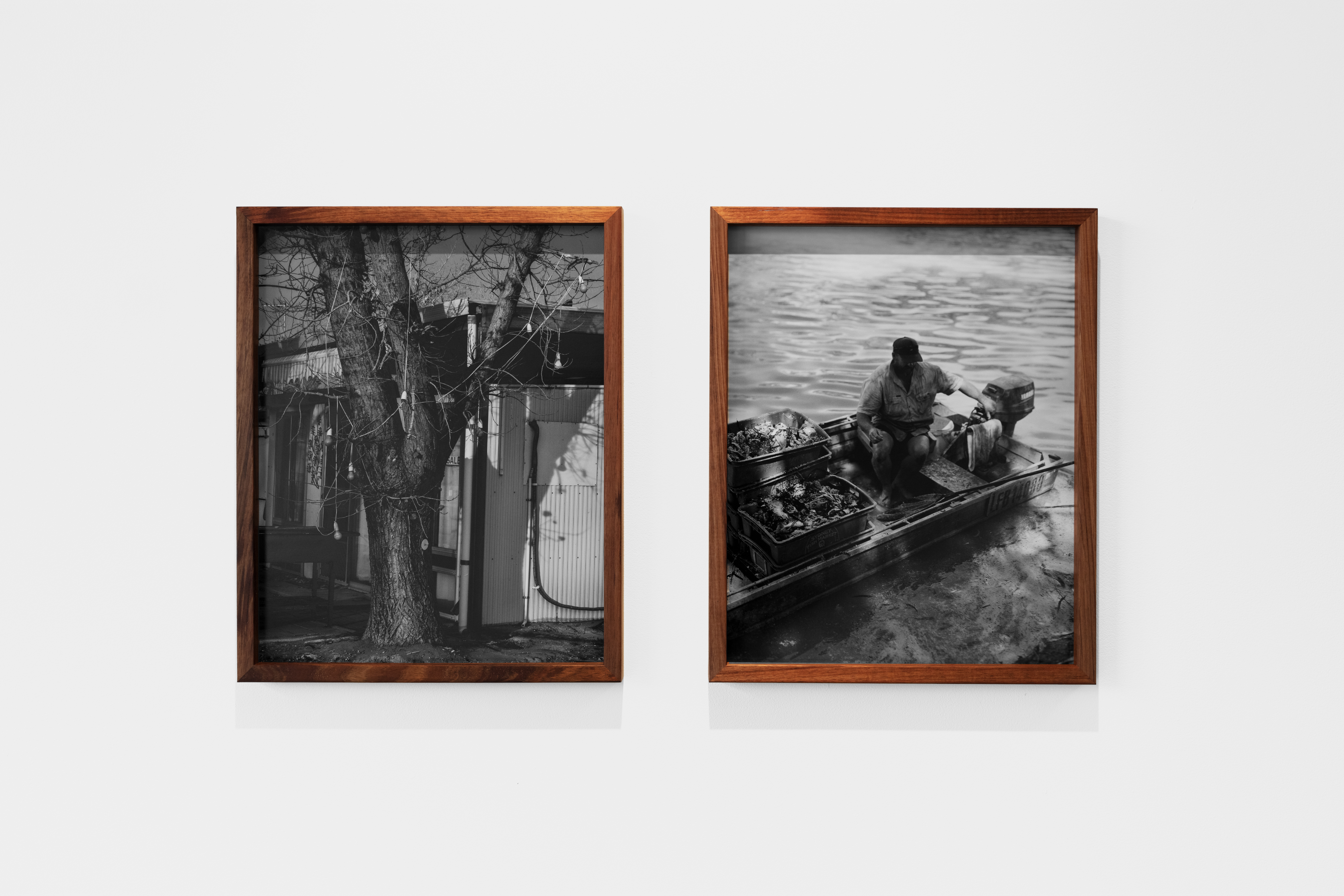
Lakshan Dharmapriya,
Pearce Leal,
The days get longer, the winds get warmer, and the world goes green again
08.09.2023 — 01.10.2023
Opening reception Friday 8 September, 6-8pm.
View catalogue
The days get longer, the winds get warmer, and the world goes green again presents two discrete bodies of work from photographers Lakshan Dharmapriya and Pearce Leal, examining the complex ecology and web of multi-species coexistence.
Although created in vastly different geographical locations, Dharmapriya’s and Leal’s respective works intertwine through a shared thematic thread - namely, the profound interconnection between humans and the natural world, how we simultaneously form, and are formed, by our surroundings.
—
Pearce Leal — Slowly Through the Grass
June, 1770. Captain James Cook’s ship runs aground at the river mouth of Waalumbaal Birri (Endeavour River). While repairs were underway, a sailor returning from patrol in a nearby forest recalls encountering a creature “black as the devil, with wings; indeed I took it for the devil, or I might easily have caught it for it crawled very slowly through the grass.”
More commonly known today as the flying fox, this ‘devil with wings’ is a migratory and nomadic keystone species in the Australian ecosystem playing a significant role through the pollination of flowers and dispersing seeds in their nighttime foraging. Roaming widely, they travel hundreds of kilometres to follow the season’s change. As native forests are cleared, and barbed wire fences are erected, they are left with few options for shelter, food and water, flocking to the allure of botanical gardens and backyards filled with ripening fruit and flowering plants.
‘We and others are entangled in knots of species who are co-shaping each other in layers of reciprocating complexity.’ Slowly Through the Grass rests on this interpretation of species articulated by Donna Haraway and engages the complex interrelationships between humans and flying foxes. This work is made through an assemblage of photographs informed by childhood memories, found materials from ecological texts, and processes of making physical interventions
on printed matter.
Slowly Through the Grass was made across various locations within the land and waterways of the Djabugay, Darumbal, Batjala and Wurundjeri Woi-Wurrung people. This land was stolen and sovereignty has never been ceded.
Pearce Leal (1993) is a photographer based in Naarm, Australia. His practice-based research explores the interrelationships between humans and fragile ecologies. He utilises traditional documentary practices, found imagery, and processes of making physical interventions on photographs to engage viewers with their own perceptions of ecologies.
Lakshan Dharmapriya — Off Season
As technology advances, the innate relationship between the human and the wild deteriorates. The battle between sustainability and progression looms hauntingly over today’s society, but that becomes exceedingly simplified when looking to nature as an example. Working animals provide an intriguing intersection between ordered human society and the wild systems of nature. For humans to get the most from an animal, one must submit to its natural cycles; huskies must rest in the warmer weather or risk overheating. They socialise, they play, they fight, organising the hierarchy of their pack before the bitter Scandinavian chill. When the cold returns, so does their winter coat. Then they work, they run.
Sled dogs are typically imagined working relentlessly in the deep snow, Off Season hopes to contribute a more holistic portrayal of their lives; an insight into the moments that allow them to reach such heights during the winter. It details the summer of a pack of Alaskan huskies, but also, the harmonies and tensions between the human and the landscape. The hiding from the midnight sun and the celebration of it too. With almost 24 hours of sunlight per day, for humans it feels like there is never enough time to fix all that needs to be fixed before winter returns.
Like a scrapbook, a found journal, someone’s love letters to nature or memoirs by nature itself, Off Season has always existed and will continue to exist even when no-one is looking. Nature is unconcerned with a final objective and is a constant reminder to rest, play and cry with the same intensity that we work. Not solely to live for the promised fruits of ambition, but for everything in between.
Lakshan Dharmapriya (b. 1998) is an artist and photographer currently based in London, UK. He has recently completed an MA in Photojournalism and Documentary Photography at LCC (2022). Using a variety of visual vehicles, he explores how humans intersect, interact and intervene with nature.


Nicholas Hubicki,
Half the World Must Be Buried Alive
as part of The Pool Grant 11
07.07.2023 — 06.08.2023
Opening reception Thursday 6 July, 6-9pm.
As the world seemed
to be only machinery
I thought it might
be a reflection
we might return
to our former
life private
too much
white house
I think half the
world must be
buried alive. It
really is not the
child’s hospital.
—Amy Sargeant
In the 1990s, Jeff Kennett’s Liberal government began closing mental health institutions in Victoria; by 2005, all had been closed. J Ward and Aradale were two of those institutions to have been decommissioned in the initial thrusts of these closures.
J Ward and Aradale existed for 130 years as mental health institutions; terms such as ‘lunatic’ and ‘insane’ were variously appended to the official titles of these institutions over the span of their operation. The relatively recent generic term ‘mental health’ cloaks and smooths - like colonialism - its own history and trajectory. Unable to utter its own history, the term presents its own ‘disorder’ as silence.
Photography abetted the institution - both penal and mental - to catalogue, describe and systemise its occupants. Half the World Must Be Buried Alive does not seek to systemise or catalogue, but to depict a certain pre-history whose mechanisms and procedures may now seem - at first glance - obsolete, yet equally informed contemporary mental health practices.
Via patient letters, instruments, admission photographs, psychopharmacological molecular models, and the spaces and environs of the institutions themselves, Half the World Must Be Buried Alive is a fragmentary portrait from a vast collective of forget.
Proudly supported by Hillvale Gallery, Prism Imaging and The Pool Collective.
Half the World Must Be Buried Alive is made possible with the support of The Pool Grant. The grant is an independent initiative fully funded by The Pool Collective. Launched in 2010, the grant was created to support the development of emerging talent within Australia and New Zealand. Since then, it has funded 10 individual artists and the first joint project in 2018/19. Throughout each project, Pool’s artists have acted as mentors to each year’s recipient, assisting with their process and guiding them through the rigours of creating a solo body of work fit for a gallery space.


Madeline Bishop,
Where does your body end
and mine begin?
17.06.2023 — 02.07.2023
| Opening reception Saturday 17 June, 3-5pm. |
Where does your body end and mine begin? is a collection of images in small sequences. The camera remains static and repeatedly captures a scene from one angle, whilst the subjects move around the room, trying to enact the same pose over and over.
“I don’t think there is ever truly a state of rest in regards to the way we try to mesh our lives with others, the way we contort our forms to fit the pieces together. Maybe there are moments of pause, our bodies in a delicate spoon, or our muscles at collapse from the wrestling, but the resistance resumes because our forms aren’t static in unison with every other tether that pulls at us. So we have to keep moving, and as a consequence we continually work at ‘figuring it out’ with the people we want to keep around. In a sense we are in a constant negotiation between what we want for ourselves and what we think others want from us. Are we stretched thin by the pushing and pulling or does it amount to growth, allowing us to expand and become bigger than we otherwise might?”
| Madeline Bishop is a photography and video artist based in Melbourne/Naarm. Bishop’s work uses a performative and constructed approach to dissecting the relationship between photography and intimacy. Bishop is a Master of Fine Arts graduate with First Class Honours from the Victorian College of the Arts in Melbourne and has recently exhibited with the Museum of Australian Photography and PHOTO2022. Bishop has been shortlisted for a number of awards, including receiving the 2020 Perth Centre of Photography IRIS Award. |


Sarah Walker,
The Well
01.06.2023 — 15.06.2023
Opening reception Thursday 1 June, 6-8pm.
The Well set into motion one icy winter after I created a series of images summing up a period of great solitude and reflection. They became a sequence of quiet contemplations on love, heartbreak, grief, family, and uncertainty. These images were left behind, only to be seen by me.
After visiting a psychic named Annabella, what was prophesied were the images I had already been making. She knew about the people closest to me, the decisions I was facing and what I cherished – it seemed like she knew everything about me then.
The impact of this reading transformed my photographs into soft premonitions. The interaction with Annabella galvanised a new way of seeing my experiences, and I began photographing the foreboding descriptions fed to me during our time together. A black dog; the moon; the sea; a strange woman.
Featuring impressions of my friends, family, sacred objects, landscapes, and dreams, this work considers the power of reflection, which for a lot of people can be led by spiritual events, such as a psychic reading.
The Well is my quiet look at life’s many turbulent turns, and is a study of my past as it merges with the present.
These images were made across the lands of the Wurundjeri Woi Wurrung and Wadawurrung People of the Kulin nation, and the Gulidjan and Gadubanud Peoples of the Eastern Maar nation, and I pay respect to elders past, present and emerging.
This exhibition is made possible by the generous support of Prism Imaging and Frames Readymade.
Sarah Walker (b. 1991) is a photo based artist living in Naarm on unceded sovereign lands of the Boon Wurrung and Woi Wurrung peoples of the Eastern Kulin Nation. Her practice centres around the psychology of myth, with a keen interest in the way people regulate their mental state in relation to their belief systems, and how this manifests itself into contemporary society. Walker is currently working on The Well, a forthcoming book, her third title published with Perimeter Editions to be released later in 2023.


Liss Fenwick,
Humpty Doom
11.05.23 — 28.05.23
Opening reception Thursday 11 May.
Humpty Doom started with pictures I took as a teenager, growing up in Humpty Doo, a rural district of the so-called “northern territory”. In the following decades I’ve explored the relations between my family and the Larrakia land we live on through photographs of our local surroundings and the three generations living there.
In making this work I think about the problematic nature of the government’s plan to “develop the north” through industry and exploitation, the sixth mass extinction event, and the dubious future of the “N.T.”.
I made this work with love.
I acknowledge the Larrakia and Wurundjeri people as the sovereign custodians of the lands and waters of Humpty Doo and Naarm respectively, as they have been for more than a thousand generations.
Bad News Books has published Liss’ forthcoming photobook Humpty Doom, designed by Stuart Geddes. The book’s launch with coincide with the exhibition and the NGV Melbourne Art Book Fair.
Humpty Doom is available for purchase via Bad News Books.
Liss Fenwick is a visual artist from Larrakia country in the Northern Territory, currently living in Naarm/Melbourne. They were awarded the Fineman New Photography Award in 2021, the Macquarie Group Emerging Artist Prize in 2018, and are currently working on a PhD at RMIT University.

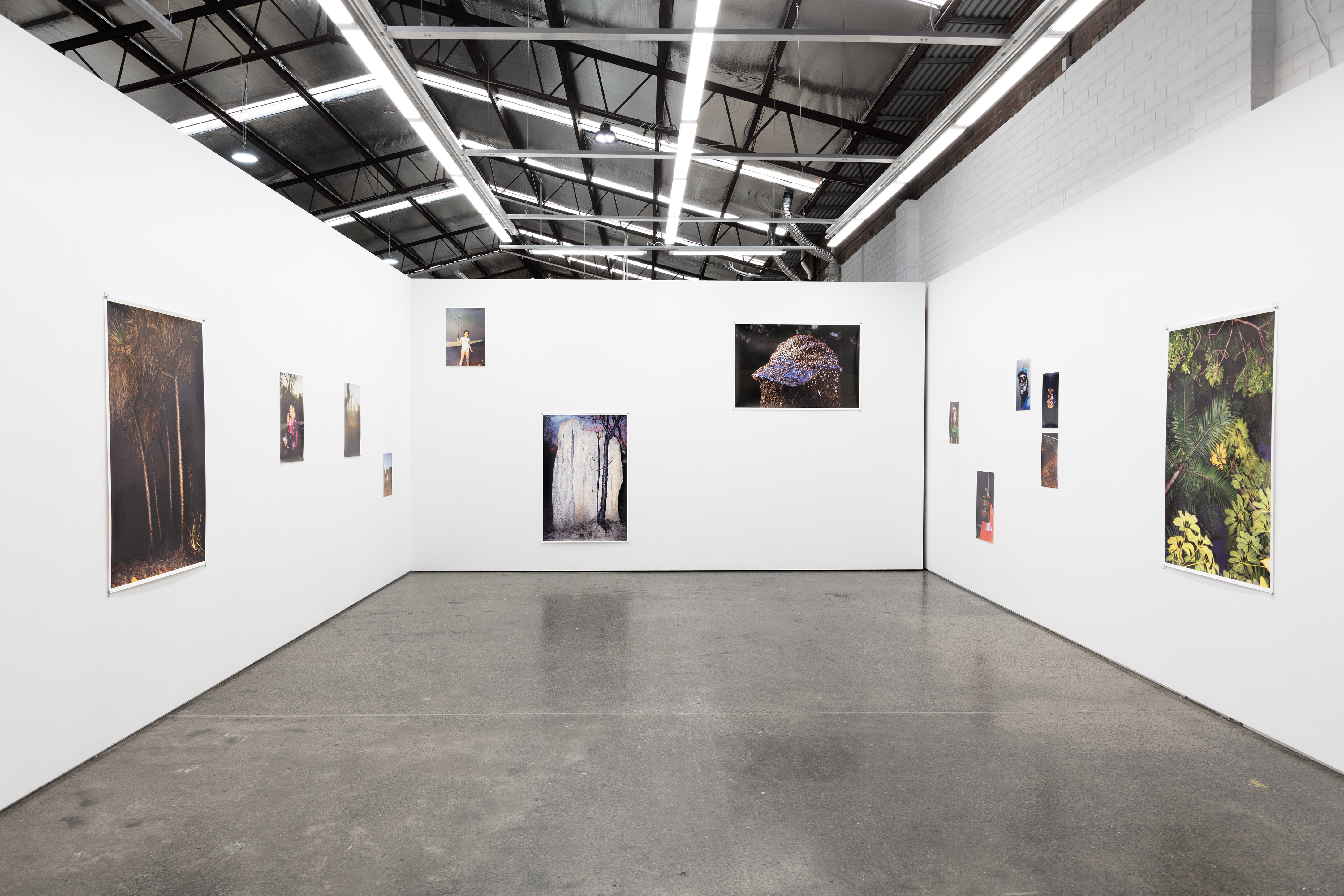
Hillvale Photo Trophy
14.04.23 — 07.05.23
Thanks to all those who contributed to this event to ensure the future of programming at Hillvale Gallery through artist fees and exhibition development.
We exhibited 729 works that were all available for purchase via QR code and our dedicated Photo Trophy website.
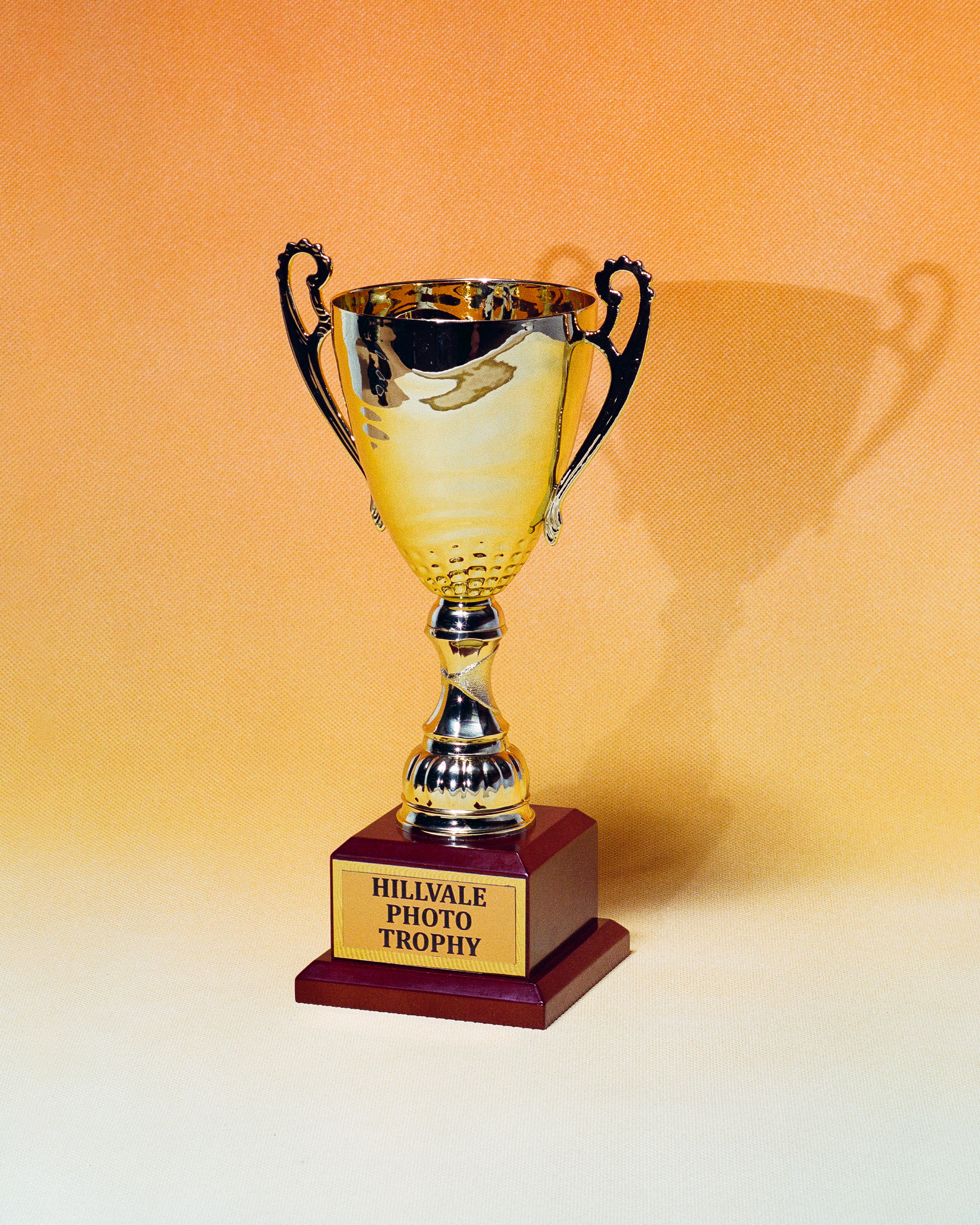
Rebecca McCauley
& Aaron Claringbold
Here’s what we know
02.03.23 — 02.04.23
Consider the telegraph poles, tracing a path walked for a very long time: adorned now with 5g transmitters. The vernacular of the powerlines and the boreholes, and the satellite mapping software that charts our course. How the distance between here and there has shrunk to the size of a holiday, or a weekend away.
This work was imaged and conceived across many locations within the lands of the Wurundjeri Woi-Wurrung, Whadjuk Nyoongar, Jinigudera, Yapurarra, Pindjarup, Nyaki Nyaki, Kalarko, Ngadju, Kaalamaya, Wongatha, Mirniny, Wirangu, Barngarla, Kokatha, Arabana, Arrernte, and Meintangk people.
Sovereignty was never ceded.
Here's what we know is about driving and tourism and extraction and technology and fantasy. It's about colonial exp(lo/i)ration mythologies, and the visual identity of the bitumen highways and carved stone that monumentalises them. About trying to make sense of all of it. It's a slide show of things we've seen, and things we think we know; about 21st century mobility and colonial place-making; and living in this place, at this time, in this way.
Installation
Front Space:
Two car seat headrest TVs on fabricated aluminium stands at the artists eye height. Video slideshows of screenshots from mapping software, moving around/discovering monuments to ‘Australian’ colonial ‘explorers’, interspersed with stills from car advertisements.
Back Space: Slide Projector with carousel playing 80 slides of artist’s photography on rotation Accompanying narration and sound design.
This project has been made possible through generous support from Yarra City Arts 2021 Annual Grants Program, and the City of Melbourne's 2020 COVID-19 quick response grants.
Aaron and Rebecca (@rebeccamccauley @toponymic_entropy) are based between the south west and the south east of the continent. As artists they are interested in the role of images in seeing and imagining the world, and try to use photography as a tool for thinking and feeling a way through the mess of now Working from their positions as settler-descendent/English they make works about how we inhabit this place; what we bring and what we take - and the many discrepancies and spaces between.


Anu Kumar,
Nagar / नगर / Town
02.12.23 — 26.02.23
Nagar - meaning Town in Hindi - is the culmination of close to ten years of making images in my birthplace of Kavi Nagar, India.
I returned to Kavi Nagar when I was 21 years old. I remember a feeling of discomfort; not knowing my place or who I was in that context. I began taking photos as an exercise in learning how to be Indian.
The images, made during daily 4pm walks with my Aunts, represent a starting point; a visual journal articulating my curiosity, responding to Kavi Nagar’s daily eccentricities whilst hovering around my family as they would move throughout the day. Over the course of this decade long journey of taking photographs, Nagar mapped my growing comfort and paved the way for a deeper connection with my family and heritage.
Anu Kumar (b. 1990, @kumar_anu) is a photographic artist living and working in Naarm (Melbourne, Australia). Working primarily with medium format photography, Anu interrogates themes of displacement and the diaspora; using her practice as a gateway to understanding her identity as a woman born in India and raised in Australia. Through her work, Anu strives to archive the quotidian expressions of everyday life as an examination of self, family and belonging. In 2022, Anu published her first monograph, titled “Ghar” with Perimeter Editions.


Hillvale,
After Hours:
A show of photography from the team at Hillvale Photo
16.12.22 — 22.01.23
Working in a photo lab, we often get asked if we take photos too. Undeniably, all of us at Hillvale picked up a camera long before commercially developing film. Who you are can’t be separated from what you do.
To round out 2022, we will be hosting a small exhibition to celebrate the photography from everyone in the team at Hillvale. This is what we do when the processors are switched off and the scanners shut down for the day. This is what we get up to after hours.
AFTER HOURS
A show of photography from the team at Hillvale Photo
FEATURING
Andy Johnson, Anne Moffat, Camille Perry, Clare Steele, Hannah Nikkelson, James Bugg, James Reynolds, Jason Hamilton, Lekhena Porter, Michael Thomas and Sarah Pannell
OPENING NIGHT EVENT
Friday 16 December 2022
6pm — 9pm
Hillvale Gallery
43-45 Edward Street
BRUNSWICK 3056
Thanks to the printing support from Prism Imaging
Drinks supplied by Heaps Normal, Bodriggy, Minimum Wines and Capi
#hillvale #hillvalegallery #hillvalephoto #yeswetakephotostoo

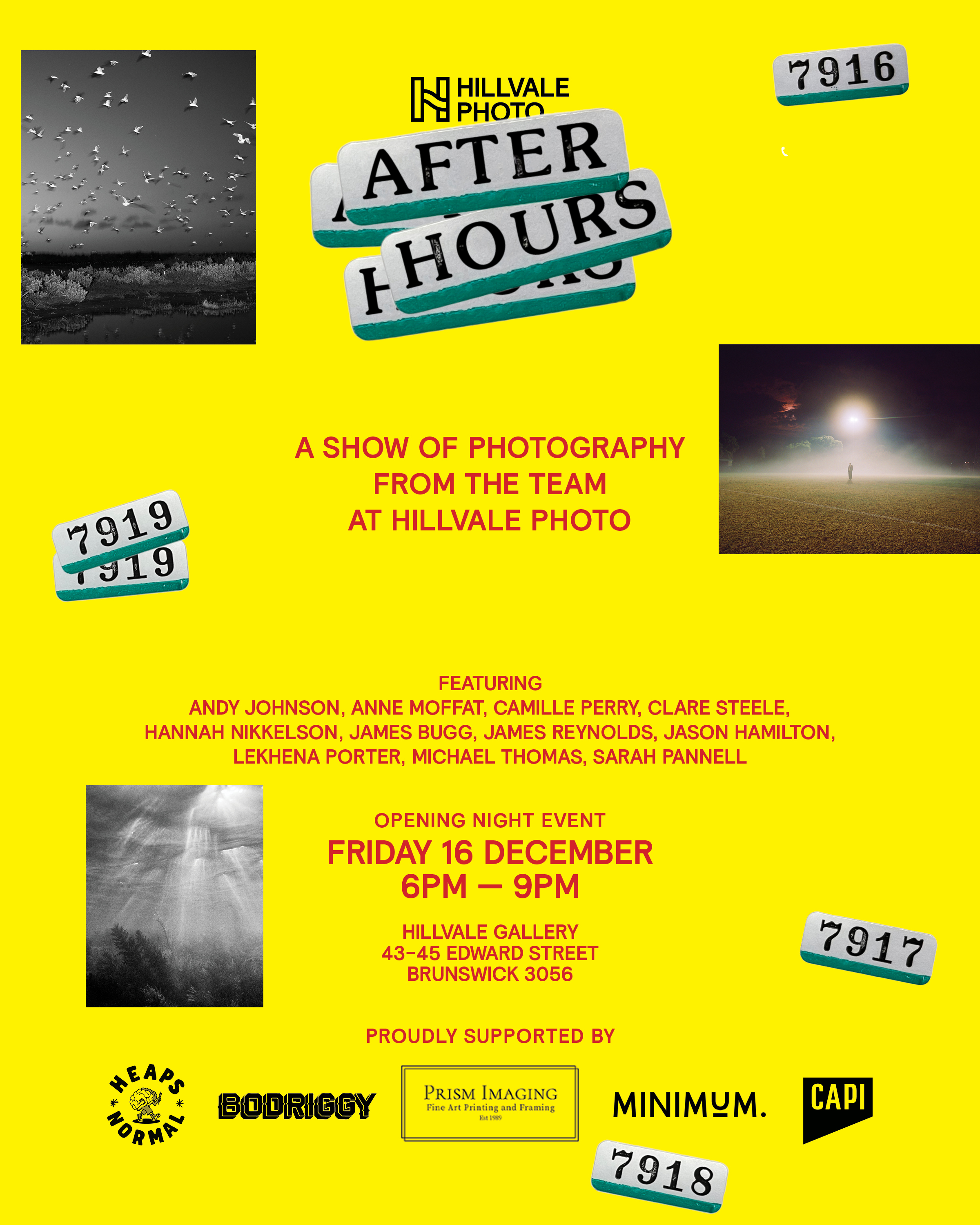

Noah Thompson,
Huon
as part of The Pool Grant 10
07.07.22 — 31.07.22
After the sudden death of my grandmother, my grandfather left his family temporarily to work in the mines on the south-west coast of lutruwita/Tasmania. I never met him. He once told my mother he would ‘run over you myself’ if she stood in front of bulldozers in protest against the construction of the major and controversial dam project, the Gordon-below-the-Franklin Dam. The dam would flood a world heritage listed rainforest in the south-west and after ongoing protests and legal challenges, it was announced that the dam would not be allowed to proceed.
Shortly after, a 2500-year-old Huon Pine, known as the Lea Tree, was vandalized by pro-dam interests. A symbol for the conservationists, the tree was chainsawed, holes were drilled into it to pour oil into its roots and finally, it was set on fire. The trunk was scrawled with the words ‘FUCK YOU GREEN CUNTS’ before the perpetrators photographed themselves in front of the still-burning tree. The resulting photograph was then sent to one of the conservation organisations.
Huon is inspired by the conflicts we have with one another over protecting or exploiting the natural world. The tensions that underpin these apparent dichotomies are not black and white but instead coloured by traditions, livelihoods and community. Reinforced by notions of how we want to live and the means by which we can, this work traces the marks we leave on the earth, ourselves and each other.
The artist would like to acknowledge the Traditional Owners and Custodians, the palawa/pakana of lutruwita (Tasmania), and pay respect to elders past, present and emerging.
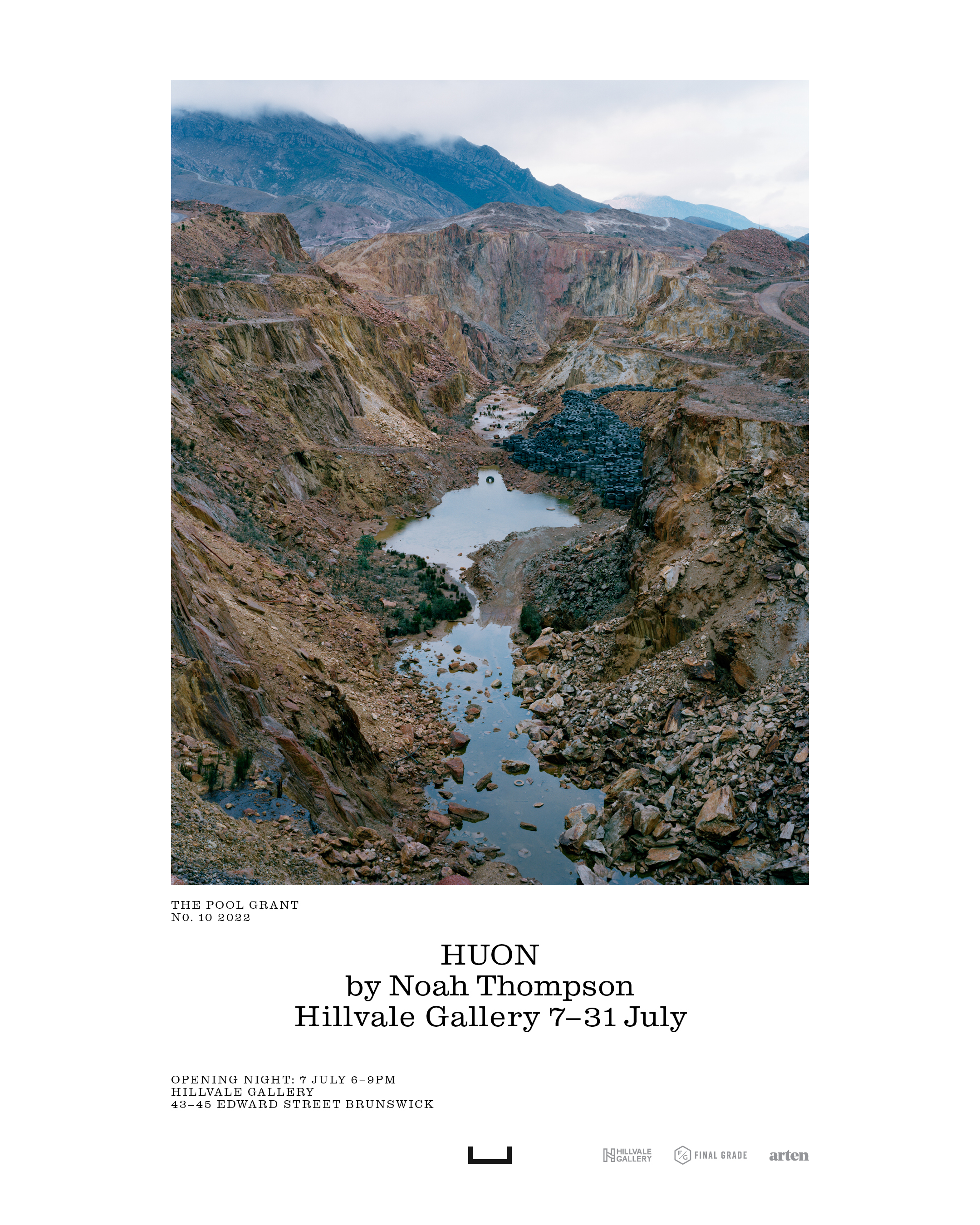
Ammar Yonis,
Out of Bounds
04.06.22 — 19.06.22
Our leisure time is influenced by where we are and the spaces available to us. But what happens when facilities are limited and there’s not much to do in the first place? Out of Bounds is a homage to the determination of youth, that no matter how limited we are by locality, our imagination will always remain free.
Growing up in Wyndham, one of Australia’s fastest expanding regions, it sometimes felt too hard to play, too far to travel, too expensive to be in a certain place but we still made the effort to hang out, determined to make fun out of nothing.
Out of Bounds explores the relationship between geography and recreation — the good, the bad and the mundane.
Exhibition runs Saturday 4 June to Sunday 19 June.
Ammar Yonis (b. 1996, Melbourne, Australia) is a Harari-Australian artist based in Melbourne’s west with a passion for storytelling. He dedicates time to exploring his creativity through mediums such as photography. His debut project Homage was exhibited in ‘Clearing the Shadow’ at Le Space (December 2019) and demonstrated his deeply vested interest in facilitating dialogue between a diversity of voices whilst fostering an atmosphere of reflection. Ammar's work blends fiction with his own realities to explore narratives that are often marginalised.
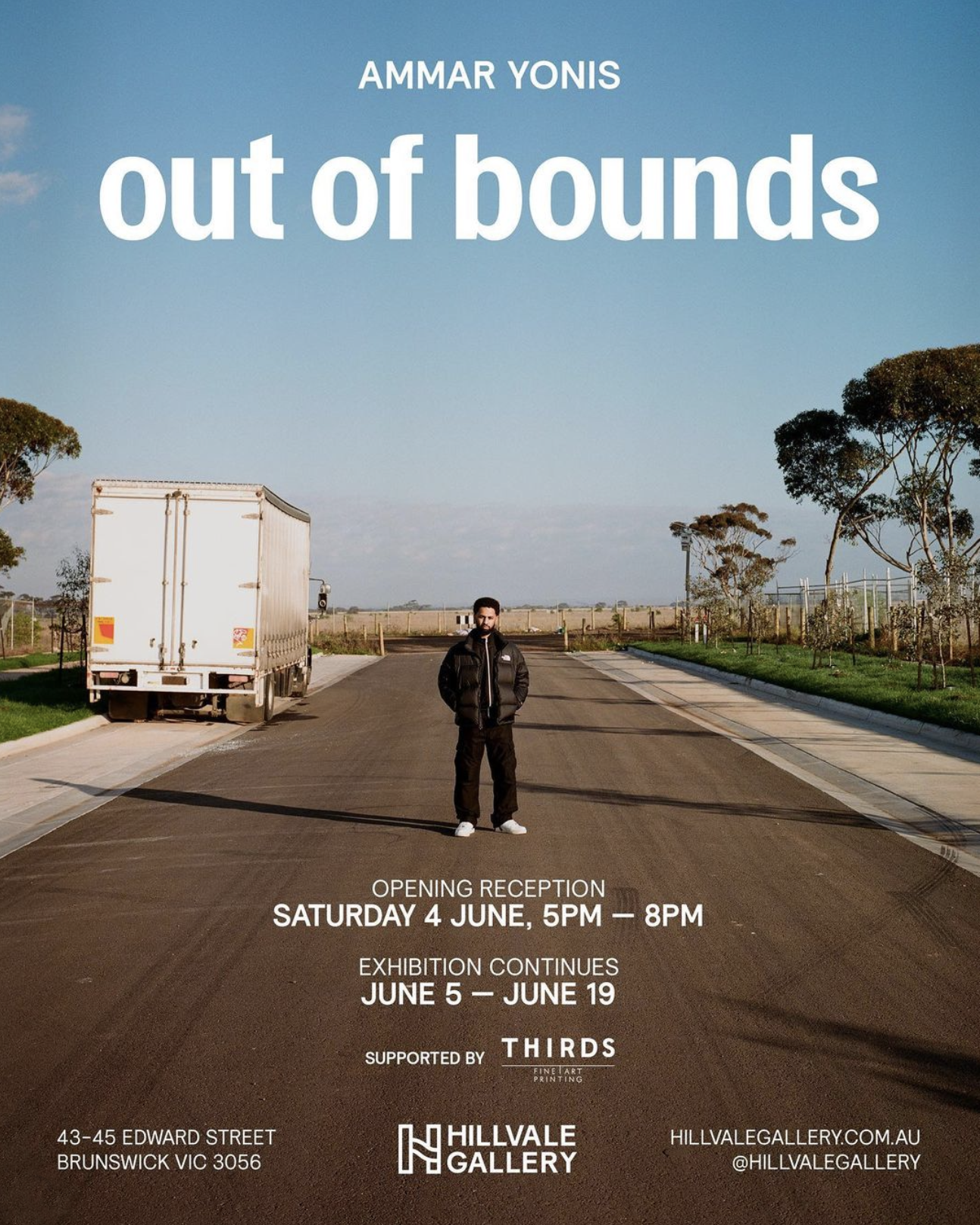
James J. Robinson,
On Golden Days
29.04.22 — 22.05.22
as part of PHOTO 2022
The past is portrayed systemically in our culture as a bygone era of innocence and purity. Through films, literature, music, we tend to reflect idealistically on collective history as a way of anaesthetising contemporary anxiety. However, this yearning for ’golden days’ means we fetishise an era where prejudice against minorities was rampant – erasing the lived experiences of marginalised peoples. Without the just retelling of history, who benefits?
Raising funds for Pay The Rent, On Golden Days takes the absurdity of glorifying the past and flips it on its head; calling on Robinson’s queer, Filipino identity to rewrite history with a series of photographs and video work starring an extensive Asian cast. This is Robinson’s first solo exhibition.
Kindly sponsored by Australia Council for the Arts, Hillvale Photo, Thirds Fine Art Printing, Icon Frames, Kayell Australia, The Vision House, Thompson Film Services, Format Scan and Graphic Content. Show runs Friday, 29 April — Sunday, 22 May with opening reception on Saturday, 30 April.
James J. Robinson (born 1995, Melbourne, Australia; lives and works Los Angeles, U.S.) is a Filipino/Australian artist based in Los Angeles. With a background in cinema and film criticism, his work pays particular attention to character, narrative and lighting. His work focusses on the power of representation, using visibility to break down systems of oppression. This style of poetic realism derives from his desire to deconstruct and heal oppressive systems within the industry, casting everyone from his family to academics and scientists he admires. His work covers photography, filmmaking, writing and lighting design, having worked with and been published by The New York Times, Vogue Australia and The Guardian.
“The Erasure of Asian Culture in 'Old Hollywood' Nostalgia”
VICE
“‘On Golden Days’ forces us to examine how we look back at the past”
Vogue Living
“Photographer James J. Robinson”
The Saturday Paper
“Unpacking the whitewashing of nostalgia through Old Hollywood”
Fashion Journal
“Bright Young Things: James J. Robinson”
Monster Children


James J. Robinson,
Masterclass: On Industry, Philosophy and Techniques
08.05.22
as part of PHOTO 2022
Aimed at students of photography and visual arts, James J. Robinson will be leading an in-depth class and discussion, covering topics like the international photography industry, the philosophy and responsibilities of photo-taking, and developing a personal style.
How do you navigate the tricky line between photography as your income and your art? What are ways we can deconstruct problematic structures in the industry? James will offer some insights, take questions, and invite some special guests on stage to offer some additional perspectives.
This talk is in conjunction with the solo exhibition On Golden Days by James J. Robinson. AUSLAN interpreter provided free on request when booking. Entry by donation to Pay The Rent.
James J. Robinson (born 1995, Melbourne, Australia; lives and works Los Angeles, U.S.) is a Filipino/Australian artist based in Los Angeles. With a background in cinema and film criticism, his work pays particular attention to character, narrative and lighting. His work focusses on the power of representation, using visibility to break down systems of oppression. This style of poetic realism derives from his desire to deconstruct and heal oppressive systems within the industry, casting everyone from his family to academics and scientists he admires. His work covers photography, filmmaking, writing and lighting design, having worked with and been published by The New York Times, Vogue Australia and The Guardian.

Another Thing To Look At While You’re Out Getting Groceries
12.07.2021 — 26.07.2021
When Melbourne was thrown back into our fourth lockdown in May 2021, we started thinking about a second outdoor exhibition. This time around we wanted to open up for submissions, and asked the wider community to show us their own striking standalone images.
The exhibition comprised six “quad” paste-ups (1.7 x 2.4m each) of our favourite images, as well as a larger site (6.7 x 2.4m) featuring the work of over 40 photographers.
Quad paste-ups: Sebastian Evans, Brian Kanagaki, Pearce Leal, Leah Hulst, Garry Trinh, Abigail Varney.
Larger site: Aaron Claringbold, Abigail Varney, Adi Dharma, Aishah Kenton, Alan Weedon, Alex Meagher, Ali Periam, Ben Buratto, Ben Hattingh, Brian Kanagaki, Bridgette Winten, Caitlin Wong, Dave Carswell, Derrick Duan, Ed Gorwell, Elizabeth Canli, Esin Ustundag, Garry Trinh, Gina Secchi, Jade Mallia, Jean Baulch, Kresimir Saban, Lakshan Dharmapriya, Laurence Watts, Lawrence McCrabb, Leah Hulst, Lil Watkin, Luke Garrett, Luke Le, Luke Pownall, Matthew Mutimer, Max Pollard, Morgan Rudolph, Nathan CCP, Pearce Leal, Phoebe Kelly, Phoebe Wynne, Rebecca McCauley, Sam Rogers, Scott Ransley, Sean Barrett, Sebastian Evans, Sophie Spence, Temitope Adesina, Thomas Feng, Wilhelm Philipp, Zoe Coldham.


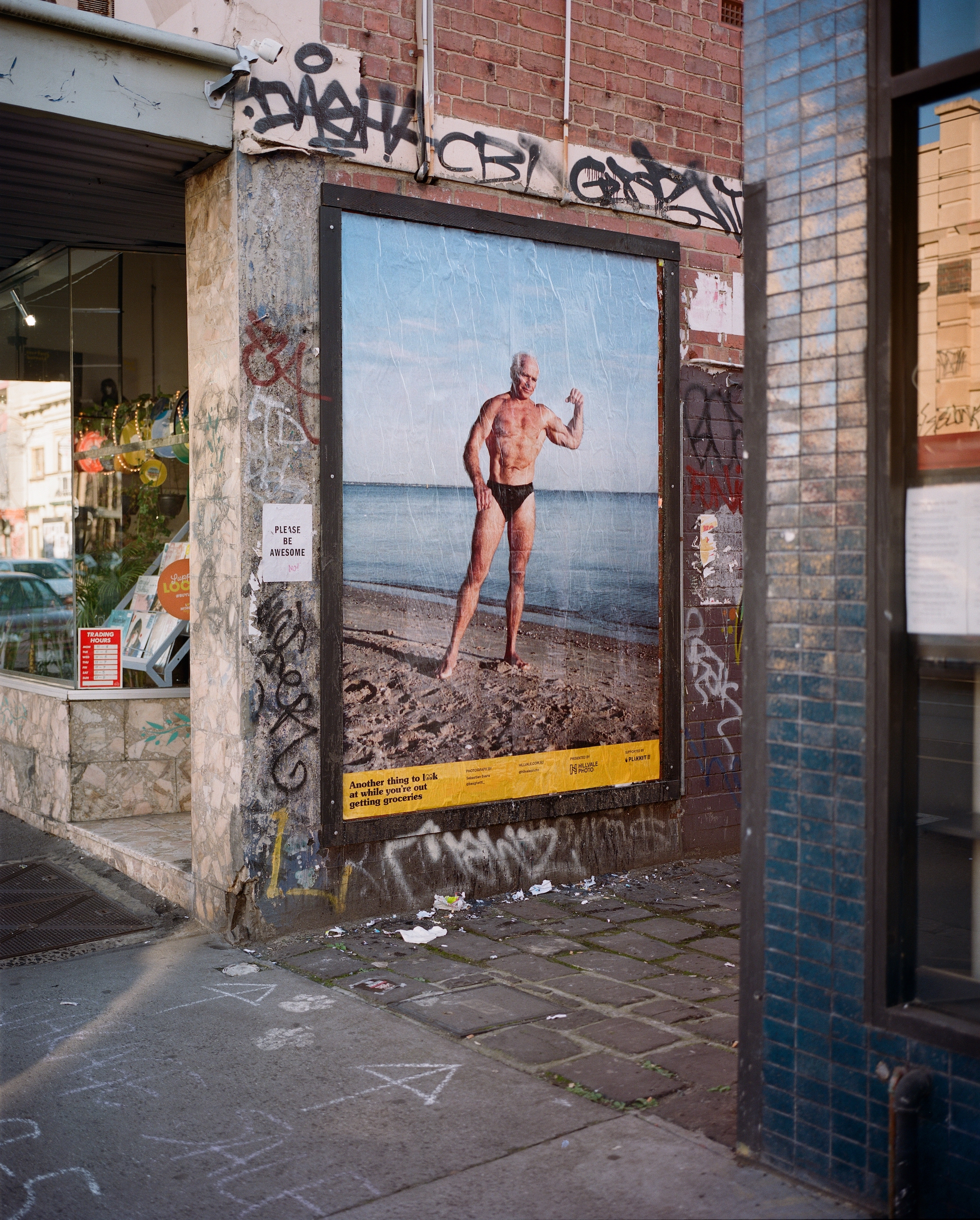



Something To Look At While You’re Out Getting Groceries
11.08.2020 — 25.08.2020
Hillvale is proud to present ‘Something To Look At While You’re Out Getting Groceries’ — an outdoor photography exhibition on the streets of Brunswick and Brunswick East.
As a photo lab run by photographers, this is our first time presenting work together in our seven years of trade. We feel this is a good time celebrate our collective vision and hope to give you something to look out for when you’re leaving home for one of the four reasons.
Featuring nine images from Andy Johnson, Anne Moffat, Clare Steele, Genevieve Walshe, Jason Hamilton, Lekhena Porter, Mathieu Mathon, Michael Thomas and Sarah Pannell.







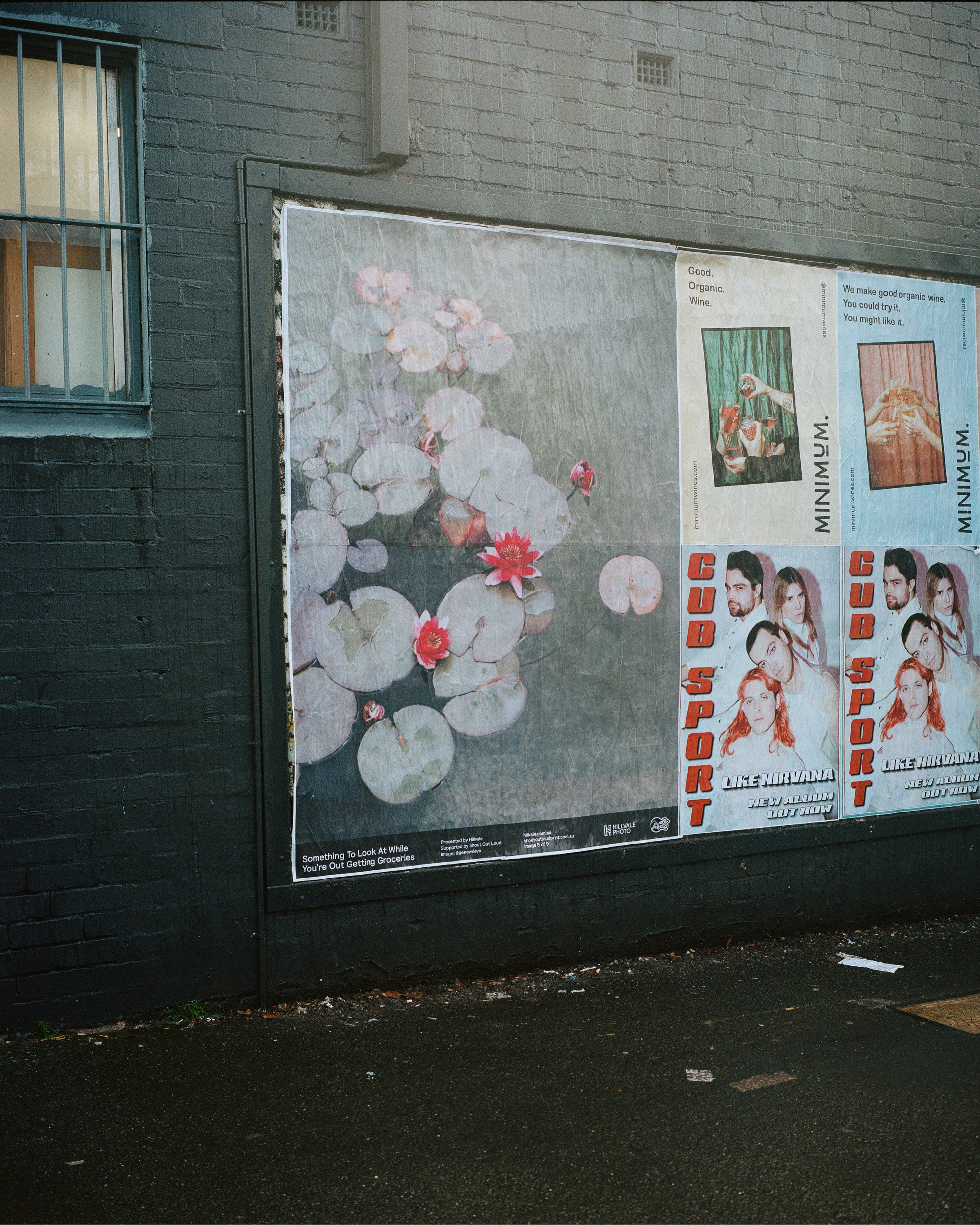

Jason Hamilton,
Living the Dream (livestream)
03.04.2020
Our exhibition launch of ‘Living The Dream’ by Jason Hamilton was scheduled to be held on Friday, 3 April. Due to to lockdown restrictions, we adapted the show to a livestream event documenting the installation of an alternate selection of photos which were left out of the original exhibition edit.
‘Living the Dream’ comprises photographs taken during Hamilton’s completion of the “big lap” — driving the entirety of Australia’s Highway 1, the longest continuous highway in the world.
Watch the entire livestream on YouTube here.

Ryan Cookson,
Tell Them About Me
29.11.2019 — 15.12.2019
A new short film and photographic project by Melbourne-based photographer Ryan Cookson offering a rare glimpse into the unique motorsport of ‘spinning’. Inspired by amateur videos of car spinners online, Cookson traveled to Soweto and Johannesburg, South Africa in 2016 and 2017, to document this subculture.
Produced by Hillvale
Melbourne, Australia ‘Tell Them About Me’
Director — Ryan Cookson
Director of Photography — Louis Mitchell
Assistant Camera — Andrew Johnson, Ryan Cookson
Editor — Raechel Harding
Original Score — Morgan Wright
Colourist — Daniel Stonehouse
Special Thanks — Hillvale, Andrew Johnson, Jason Hamilton, Pule Earm Motloung, Lucas 'Seku Rite', Thabo & Bafana 'DK Spinners', Ruffy & the Westside Spinners, Faizel, Feroz, Rio and Flossy
Supported by the Hillvale Project Grant
With special thanks to Thirds Fine Art Printing and Heimur

Sarah Pannell,
Tabriz to Shiraz
10.04.2019 — 05.05.2019
Tabriz to Shiraz is the debut book project by Melbourne-based photographer Sarah Pannell. The publication draws on a vibrant series of photographs taken during her travels through Iran in 2016 and 2017, which saw her navigate vast stretches of the country. On her first visit, she travelled from the capital, Tehran, north to Qazvin and west to Tabriz, south to Isfahan and Shiraz, and east to Kerman and Yazd, while on her second trip she explored regions such as the Gilan Province, which borders the Caspian Sea, and Kurdistan in the mountainous region bordering Iraq.
Beyond that of a mere travelogue, the book assumes a position that flits between the poetic, intimate, incisive and playful in its un-layering of contemporary Iran’s visual, cultural and architectural languages and subjectivities. Across photographic modes spanning portraiture, landscape, architecture and impromptu formalism, Pannell offers a series of vantages on a place that proves at once familiar, foreign and happily jarring in its multiplicity.

Keep The Fire Burning
30.11.2018
A celebration of five years of Hillvale with a projection-based group exhibition.
⠀⠀
We had an overwhelming response with 605 entries. We truly appreciate the support over these past 5 years — it’s what makes Hillvale special to us. It was great to see so many entries from across the globe, with kind words of appreciation.
⠀⠀
Photos from Aaron Chapman, Aaron Claringbold, Abigail Varney, Adelina Onicas, Aishah Kenton, Alex Johnstone, Alex Meagher, Amber Maree, Andy Johnson, Andy MacRae, Anne Moffat, Arda Satata Fitriajie, Asia Taylor, Baris Bulut Karabulut, Bella Capezio, Ben Christensen, Ben Clement, Ben Hattingh, Ben Hermans, Blythe Kirk, Brodie Lancaster, Brynn Chadwick, Caroline Goessling, Catherine Drysdale, Chris Moses, Christopher Sutherland, Clare Steele, Coby Baker, Craig Lyons, Damien Laing, Damien Melchiori, Daniel Wilson, Darsh Seneviratne, Dylan Dimovski, Dylan Ooster, Emmaline Zanelli, Felix Atkinson, Garry Trinh, Greg Holland, Guy Heath, Hannah Nikkelson, Heide Peverelle, Jack MacKinnon, Jack Shelton, Jacky Hawkeswood, Jaclyn Paterson, Jacob Strasser, James Bugg, James Whiting, Janomes Martinez, Jason Hamilton, Joe Nigel Coleman, John Bollen, Joo Anna Oh, Joseph Liu, Judy Turner, Kae Kitzler, Karl Halliday, Kate Moffat, Klari Agar, Kosta Greig, Kres Saban, Lakshan Dharmapriya, Laurence Watts, Lekhena Porter, Leonardo Magrelli, Liam Brownlie, Louis Mitchell, Lucy Hillman, Luke Byrne, Luke Murray, Luke Pownall, Luke van Aurich, Madz Rehorek, Marc Harpur, Marcelle Bradbeer, Mathieu Mathon, Matthew Foy, Matthew Justice, Max Turner, Maximillian Williams, Michael Danischewski, Michael Garbutt, Michael Thomas, Michaela Dutkova, Nadia Mizner, Natasha Cantwell, Nic Ojae, Nusha Gurusinghe, Oliver Hodgkins, Ophelia Bakowski, Paul Handley, Pearce Leal, Phillip Dixon, Rebecca McCauley, Robyn Daly, Rubin Utama, Ryota Hisanabe, Sam Rogers, Samuel Nolan, Sarah Pannell, Sean Barrett, Shannon Rush, Shea Kirk, Simon Peel, Sonny Witton, Stacey Zalomski, Thomas McCammon, Timothy Hillier, Vanessa Howells, Wilhelm Philipp, Will Vink, Xiao Xue Tang, Zoie Kasper.

Flat Film Archive
16.12.2017
The Flat Film Archive was borne out of the Hillvale Cubes. Sifting through each roll of film in preparation for the cubes’ construction, it was discovered that every canister was unique in its own right.
Although 35mm film is produced in a uniform fashion (from small-run hand rolled film to mass manufacturing), each roll has individual markings — from hand written notes, varying imperfections and expiration dates.
This evolving archive serves as an appreciation of 35mm canister design. Visit our catalogue online at flatfilmarchive.com. You can also follow along on Instagram, @flatfilmarchive.
Photography Studies College,
NOWHERE
18.11.2017
Photography Studies College’s Bachelor of Photography second year cohort’s end of year exhibition. NOWHERE brings together handmade photobooks and prints from each student, the culmination of their second year work.

Dysturb,
Where I Lay My Head
17.05.2017 — 31.05.2017
Dysturb are a community of freelance photojournalists who place current international photojournalism in public spaces. We were thrilled to have them here in Australia raising awareness with a week-long campaign titled 'Where I Lay My Head'. During this week Dysturb installed large-scale photojournalism around the greater Melbourne region, featuring nine photographers from around the world whose work explores the issue of displacement.
As part of this campaign we helped out by holding a parallel exhibition at Hillvale Gallery, featuring further work from each photographers' series, plus two additional photographers. This campaign highlights the increasing numbers of displaced persons, and how families and communities are affected by displacement.
Exhibiting photojournalists included Ismail Ferdous, Malin Fezehai, Barat Ali Batoor, Daro Sulakauri, Emin Ozmen, Ashley Gilbertson, Jane Hahn, Laura Boushnak and Alexandra Rose Howland. Additional work shown in the gallery included Amr Alfiqy and Alana Holmberg, plus a 350 virtual reality story made by S1T2 in collaboration with World Bank.
Big thanks to our print sponsors Prism Imaging and a special mention to the numerous volunteers from the photo community in Melbourne for all your painting, pasting and lifting.





The Hillvale Stitch-Up Machine
as part of IPF
20.11.2016
An installation comprising over 5 metres of C-41 negatives photographed by 21 artists, including Alan Weedon, Anne Moffat, Anna Oh, Bella Capezio, Clare Steele, Daniel Wilson, Jacky Hawkeswood, James Robinson, James Whiting, Janelle Low, Luke Le, Marcelle Bradbeer, Mia Mala McDonald, Phoebe Veldhuizen, Ryan Kenny, Sam Wong, Sarah Pannell.
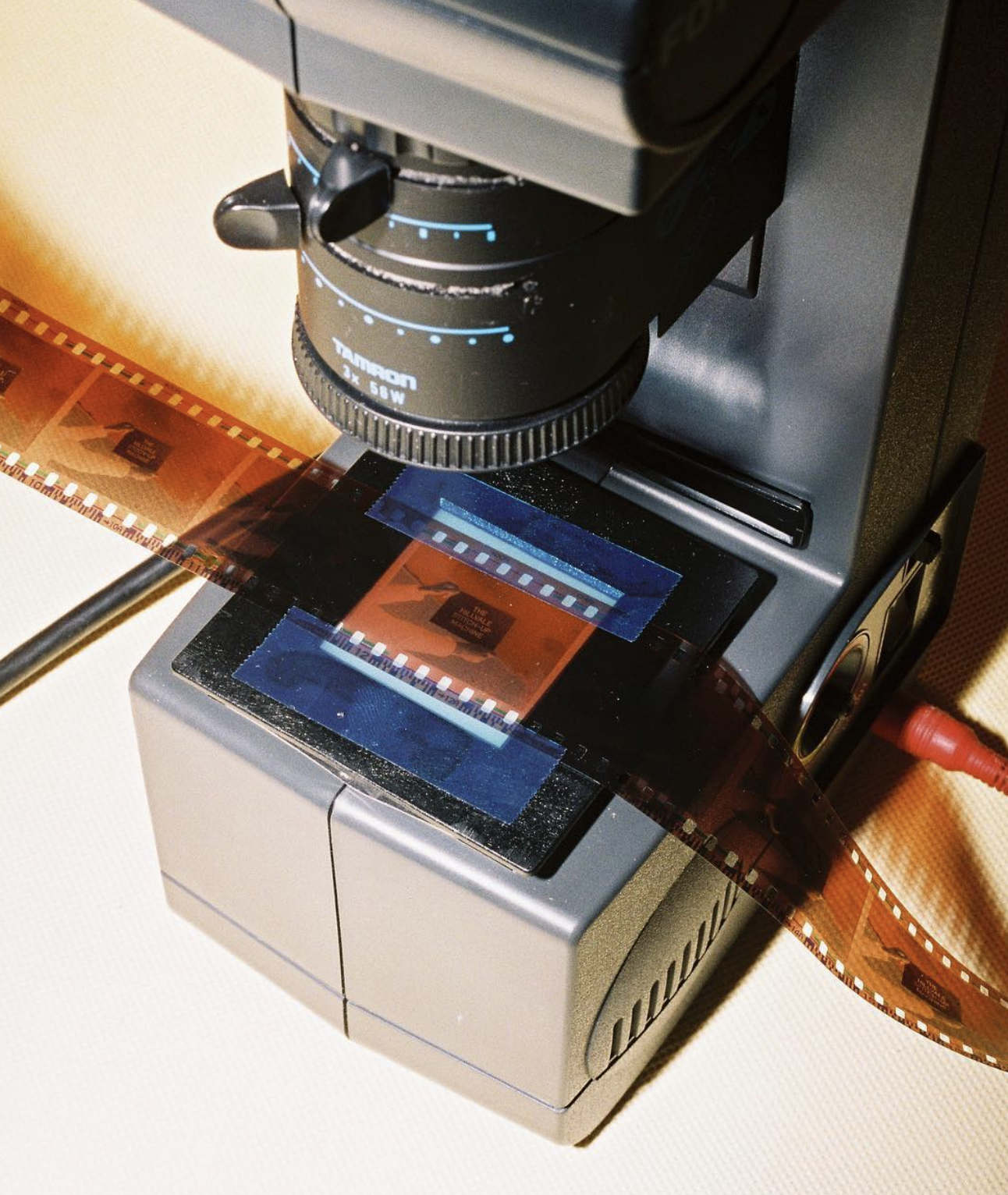
Michael Thomas,
Night Works
14.01.2016 — 31.01.2016
The second instalment of 'We Saw It Before You' and the first showcasing of a solo body of work, shot by Michael Thomas between 2012-2015. This was Thomas’ first solo exhibition and publication release. Thanks to Heimur for making the large scale lightboxes possible, as well as Daniel Boetker-Smith of Asia-Pacific Photobook Archive / Photobook Melbourne for the opening essay. Many thanks also to Thirds Fine Art Printing and Bond Imaging.
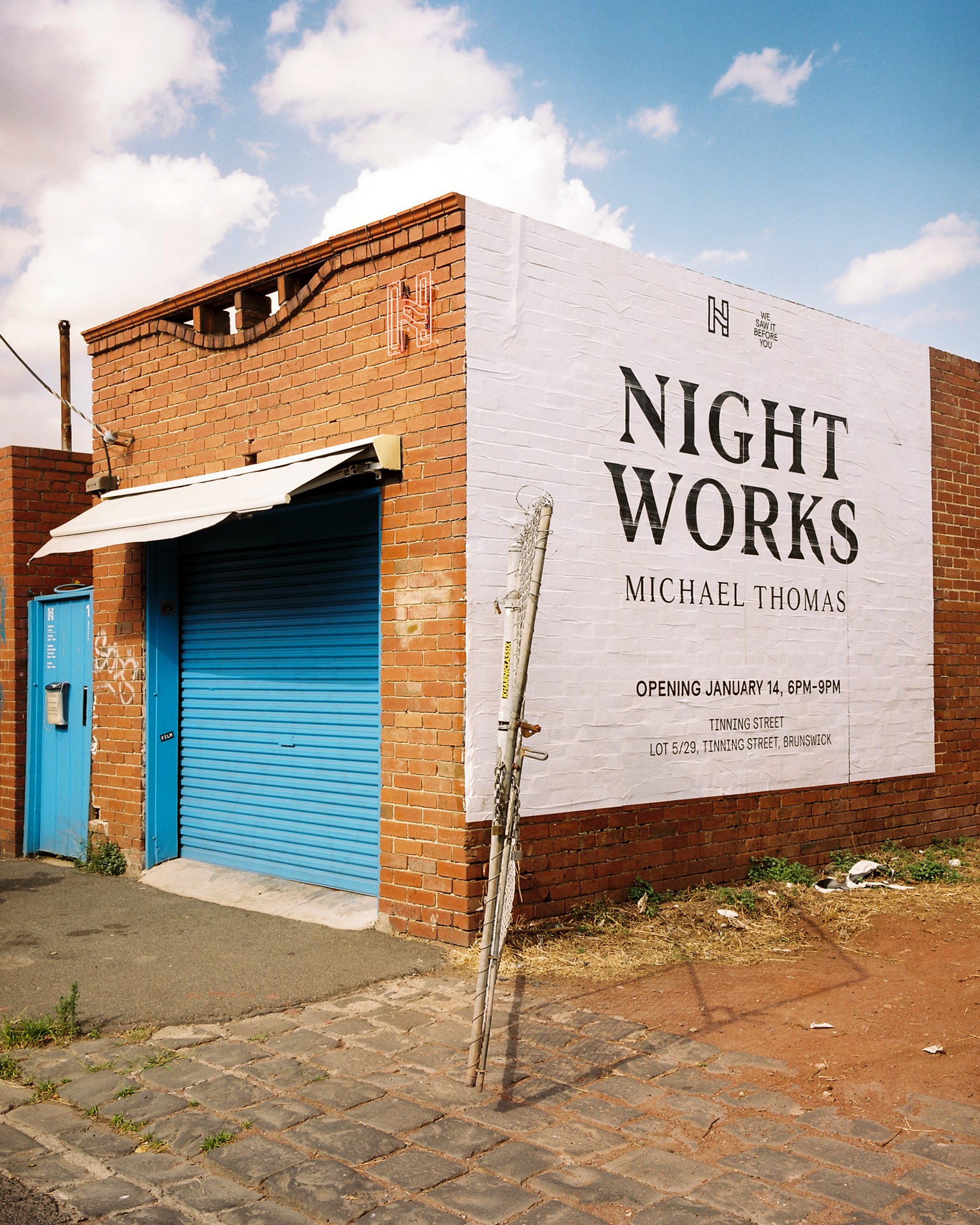



We Saw It Before You
18.09.2014
Exhibition and publication launch with images from the first year of Hillvale.
Photographs by Max D’orsogna, Ryan Cookson, Sarah Pannell, Rafferty Bailey, Hilary Sloan, Henry Johnson, Adelina Onicas, Luke Pownall, Jason Hamilton, Jack Shelton, Ché Parker, Jayden Reynolds, Maxwell Finch, Jessica Brent, Jack Harries, Matthew Stanton, Benjamin Lichtenstein, Streety, Luke Byrne, Sophie Gearon, Anthony Robinson, Caitlin Molloy, Emma Perry, Simon Aubor, Bec Capp, Mitch Pinney, Paul John Nelson, Lloyd Stubber, Timothy Hillier, Sam Wong, Ben Clement, Michael Danischewski, Joel Bouchier, Ed Gorwell, Nusha Gurusinghe, Damien Melchiori, Kresimir Saban, Nick Wilkins, Charlie Brophy, Luke Van Aurich, Madeline Burke, Jay Dymock, Kristina Arnott, Red Stevenson, Yasmin Nebenfuhr, Nicholas Hawker, Andrew Johnson, Morgan Hickinbotham, Nadia Mizner, Michael Thomas.








